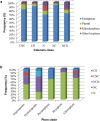A computational study on the structure-function relationships of plant caleosins
- PMID: 36593238
- PMCID: PMC9807586
- DOI: 10.1038/s41598-022-26936-y
A computational study on the structure-function relationships of plant caleosins
Abstract
Plant cells store energy in oil bodies constructed by structural proteins such as oleosins and caleosins. Although oil bodies usually accumulate in the seed and pollen of plants, caleosins are present in various organs and organelles. This issue, coupled with the diverse activities of caleosins, complicates the description of these oleo-proteins. Therefore, the current article proposes a new classification based on the bioinformatics analysis of the transmembrane topology of caleosins. Accordingly, the non-membrane class are the most abundant and diverse caleosins, especially in lower plants. Comparing the results with other reports suggests a stress response capacity for these caleosins. However, other classes play a more specific role in germination and pollination. A phylogenetic study also revealed two main clades that were significantly different in terms of caleosin type, expression profile, molecular weight, and isoelectric point (P < 0.01). In addition to the biochemical significance of the findings, predicting the structure of caleosins is necessary for constructing oil bodies used in the food and pharmaceutical industries.
© 2023. The Author(s).
Conflict of interest statement
The author declares no competing interests.
Figures






Similar articles
-
Characterization of a caleosin expressed during olive (Olea europaea L.) pollen ontogeny.BMC Plant Biol. 2011 Aug 31;11:122. doi: 10.1186/1471-2229-11-122. BMC Plant Biol. 2011. PMID: 21884593 Free PMC article.
-
Structure and function of seed lipid-body-associated proteins.C R Biol. 2008 Oct;331(10):746-54. doi: 10.1016/j.crvi.2008.07.016. Epub 2008 Sep 4. C R Biol. 2008. PMID: 18926488 Review.
-
Identification and characterization of caleosin in Cycas revoluta pollen.Plant Signal Behav. 2020 Aug 2;15(8):1779486. doi: 10.1080/15592324.2020.1779486. Epub 2020 Jun 17. Plant Signal Behav. 2020. PMID: 32552503 Free PMC article.
-
Proteomic analysis of oil bodies in mature Jatropha curcas seeds with different lipid content.J Proteomics. 2015 Jan 15;113:403-14. doi: 10.1016/j.jprot.2014.10.013. Epub 2014 Oct 28. J Proteomics. 2015. PMID: 25449834
-
Biogenesis and functions of lipid droplets in plants: Thematic Review Series: Lipid Droplet Synthesis and Metabolism: from Yeast to Man.J Lipid Res. 2012 Feb;53(2):215-26. doi: 10.1194/jlr.R021436. Epub 2011 Nov 1. J Lipid Res. 2012. PMID: 22045929 Free PMC article. Review.
Cited by
-
Exploiting lipid droplet metabolic pathway to foster lipid production: oleosin in focus.Plant Cell Rep. 2024 Dec 26;44(1):12. doi: 10.1007/s00299-024-03390-w. Plant Cell Rep. 2024. PMID: 39724216 Review.
References
MeSH terms
Substances
LinkOut - more resources
Full Text Sources

